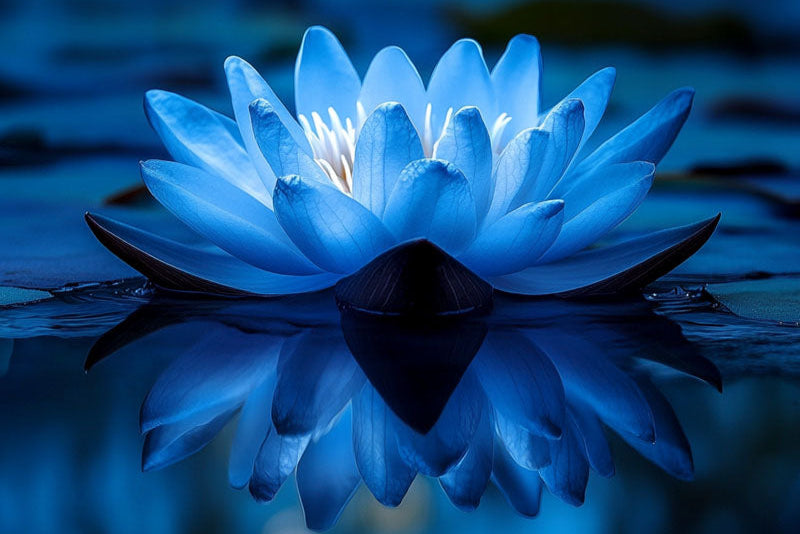Table of Contents
- Introduction
- 1. Ancient Origins – The Sacred Flower of the Nile
- 2. Symbolism and Myth in Egypt, Greece, and India
- 3. Botanical and Pharmacological Profile of Nymphaea caerulea
- 4. Blue Lotus in Ceremony, Tantra, and Meditation
- 5. The Modern Revival: Tea, Tincture, and Vaporization
- 6. How to Vaporize Blue Lotus for Subtle Effects
- 7. Blue Lotus in the Age of Conscious Living
- Conclusion
- About the Author
The Enigmatic Blue Lotus: History, Science, and Its Modern Revival
There are plants we consume for healing, others for pleasure, and still others for altered states of awareness. Then there is Blue Lotus — a flower that sits at the intersection of all three. Revered by pharaohs, painted on temple walls, sipped in sacred rituals, and now rediscovered by modern seekers, Nymphaea caerulea — the Blue Lotus — is more than just a botanical curiosity. It is a symbol of presence, sensuality, and expanded consciousness.
Used in ancient Egypt as both a ceremonial aid and a mild euphoric, this aquatic flower has found new life among herbalists, breathworkers, and vaporization enthusiasts who seek a more intuitive, natural high. But what is the Blue Lotus, really? Where did it come from? How does it work? And why are people once again drawn to it?
This article dives deep into the myth, science, and experience of Blue Lotus — from ancient altars to modern altars, from sacred tea to slow vapor.
1. Ancient Origins – The Sacred Flower of the Nile
The Blue Lotus, also called the Egyptian water lily, is native to the Nile River basin and was revered by the ancient Egyptians as a sacred, transformative flower. Appearing frequently in hieroglyphics, temple carvings, and burial paintings, it was associated with the sun, rebirth, and the afterlife.
Archaeologists have found depictions of the Blue Lotus in the hands of gods and goddesses like Nefertem and Hathor. It appears in the famous “party scenes” of the Tomb of Nakht, where nobles are shown reclining, drinking blue lotus wine, and holding blossoms to their noses.
Far from being mere decoration, the Blue Lotus was a ceremonial and psychoactive plant used to facilitate altered states of consciousness. Many historians believe it was infused into wine or steeped as tea during religious ceremonies — possibly as a tool for inducing lucid dreaming, erotic openness, or meditative stillness.
In Egyptian cosmology, the Blue Lotus was also a symbol of cosmic rebirth. Each morning, its petals opened with the rising sun, and each evening, they closed again. For this reason, it was planted in tombs and painted on sarcophagi as a representation of the soul’s journey through light and darkness.
To the ancient Egyptians, Blue Lotus was more than a plant — it was a portal.
2. Symbolism and Myth in Egypt, Greece, and India
While Egypt is the historical heartland of Blue Lotus culture, the flower’s symbolism resonates throughout the ancient world. In Greece, it was often confused with the similarly named Nelumbo nucifera, the sacred pink lotus of India, but references to “lotus eaters” in Homer’s Odyssey suggest knowledge of mild, mood-altering aquatic flowers.
In India, the concept of the lotus — though referring botanically to a different species — symbolizes spiritual awakening, chakra alignment, and inner beauty. The lotus grows from mud and blossoms in still water — a metaphor for human consciousness rising from the depths of suffering into the light of awareness.
While Blue Lotus is not used as extensively in Vedic texts as the pink or white lotus, its energy aligns with similar teachings: heart opening, sensuality, cyclical renewal. Some tantric traditions use lotus imagery as a vehicle for sacred union — between breath and body, self and other, earth and spirit.
The recurring theme across cultures? The lotus as a bridge — between worlds, elements, and states of being.
3. Botanical and Pharmacological Profile of Nymphaea caerulea
Botanically speaking, Nymphaea caerulea is a water lily — not a true lotus — but it shares many of the same spiritual and visual traits. Its sky-blue petals and golden center give it an ethereal appearance, especially when blooming in early morning light.
Phytochemical studies have shown that Blue Lotus contains several interesting active compounds, most notably:
- Apomorphine – a dopamine receptor agonist known for mild euphoria and enhanced introspection
- Nuciferine – a psychoactive alkaloid thought to have calming, antipsychotic, and anxiolytic effects
- Phenolic compounds – contributing antioxidant and anti-inflammatory properties
These compounds are thought to interact with the dopaminergic and serotonergic systems, explaining the subtle, dreamy effects often reported by users — a kind of waking lucid dream state that heightens mood, sensuality, and presence.
Unlike THC or psilocybin, Blue Lotus is not a strong psychedelic. It is gentle. Subtle. Soft. But therein lies its power. As modern herbalists and vaporization users rediscover, sometimes the lightest touch creates the deepest shift.
According to a 2022 review in Plants, extracts from Nymphaea species may also hold promise for anti-inflammatory and neuroprotective applications, opening the door to both recreational and therapeutic use.
4. Blue Lotus in Ceremony, Tantra, and Meditation
Across millennia, Blue Lotus has been used as a bridge to altered states — but not in isolation. It has always been part of ceremony. In ancient Egypt, it was steeped in wine during temple rituals. In modern wellness spaces, it is infused into breathwork, cacao ceremonies, or sound journeys.
In tantric and yogic practices, Blue Lotus is increasingly used to support heart opening and energetic balance. Practitioners often report heightened sensitivity, emotional release, and softening of internal resistance. It pairs beautifully with slow breathwork, eye gazing, and stillness.
Because it is non-psychedelic and legally accessible in most countries, Blue Lotus offers a gentle alternative for those seeking a sacred container without the intensity of stronger plant medicines. It is especially suited to rituals of intimacy, reflection, and feminine embodiment.
One user described it this way: “It doesn’t take you away. It brings you back.”
Whether sipped as tea, held in a pipe, or vaporized with presence, Blue Lotus invites you to slow down — and to feel more.
5. The Modern Revival: Tea, Tincture, and Vaporization
In recent years, Blue Lotus has experienced a powerful resurgence — not in museums, but in modern rituals. Wellness communities, herbalists, and psychonauts alike are exploring it as a gentle plant ally for mood, meditation, and sensuality.
Today, Blue Lotus is enjoyed in many forms:
- Tea: Steep dried flowers in hot water (not boiling) for 10–15 minutes. Adds a floral sweetness and a dreamy calm to any evening.
- Wine infusions: Ancestral-style maceration of the flowers in red wine for 24–48 hours can awaken its euphoric notes. Ideal for ceremonial toasts or shared intimacy.
- Tinctures: Alcohol or glycerin extracts offer precise dosing and faster absorption. Great for travel or microdosing.
- Vaporization: Perhaps the most underrated method — Blue Lotus releases its subtle aroma and active compounds best at light heat, making it a perfect fit for analog vaporizers.
Because the effects are subtle, Blue Lotus is often combined with breathwork, yin yoga, journaling, or slow music. It enhances whatever you bring to it — not through distortion, but through amplification of stillness.
This is what makes it ideal for vaporization: a microdosing-friendly flower that rewards presence over potency.
6. How to Vaporize Blue Lotus for Subtle Effects
Unlike dry herbs that release intense vapor and rapid effects, Blue Lotus is a soft botanical. When vaporized gently, it creates an aromatic cloud with floral sweetness and calming undertones. You won’t get “high” — but you may feel more embodied, emotionally open, or creatively attuned.
Here’s how to vaporize Blue Lotus properly:
Recommended Setup:
- Vapman Click: Perfect for light, controlled heating. Add 0.05–0.1g of dried Blue Lotus petals. Use a low flame and wait for the click.
- Lotus Vaporizer: Works well with a flower chamber packed loosely with crushed petals. Slow flame rotations ensure even heating.
Temperature Range:
- 175–185°C (347–365°F) is ideal
- Too much heat will destroy aromatics — go slow and low
Pro Tips:
- Grind lightly with fingers — avoid powdering the petals
- Try mixing with damiana, lavender, or dried rose for a synergistic blend
- Use during breathwork or journaling for a grounded and open state
The goal isn’t to escape. It’s to drop in.
Vaporized Blue Lotus is a practice of inhaling softness — and of remembering that the most profound experiences are sometimes the most subtle.
7. Blue Lotus in the Age of Conscious Living
In a world increasingly dominated by stimulation, schedules, and screens, Blue Lotus offers a different kind of medicine — not to push harder, but to slow down. It belongs to the new era of conscious living: a movement that values intentionality over intensity, presence over productivity, and ritual over routine.
Unlike stronger plant allies like psilocybin or ayahuasca, Blue Lotus doesn’t overwhelm. It whispers. It nudges. It opens a space — for listening, breathing, and reconnecting to what’s beneath the noise.
That’s why it pairs beautifully with analog tools and tactile rituals — flame-powered vaporizers, slow-brew teas, handwritten reflections. When you inhale Blue Lotus with something like the Vapman Click or Lotus, you’re not just inhaling a plant. You’re inhaling a moment of awareness.
As we enter an era of deeper self-care and plant-based exploration, Blue Lotus stands out not for what it makes you feel — but for what it helps you notice. In this way, it’s not a shortcut to altered states — it’s a soft return to your natural one.
Conclusion
For thousands of years, the Blue Lotus has been a flower of wisdom, beauty, and breath. From Nile rituals to modern wellness circles, it has always symbolized something beyond words — a quiet, sacred space within us.
Today, as we rediscover ancient plants through a new lens, Blue Lotus is finding its place not as a trend, but as a timeless companion — gentle, fragrant, and full of presence. Whether you sip it in tea, share it in ceremony, or vaporize it with care, it invites the same thing: to slow down, to open your heart, and to inhale consciously.
Ready to breathe in the stillness?
→ Explore our handcrafted vaporizers designed for botanicals like Blue Lotus
About the Author

Author: Michael Mussner, Founder of INHALE Vaporizers
Michael is a passionate vaporizer designer and entrepreneur from South Tyrol, driven by craftsmanship, sustainability, and the mindful use of natural herbs. With a background in product innovation and a love for analog technology, he founded INHALE to revive flame-powered vaporizers like the Vapman and Lotus. Every product he creates is deeply rooted in authenticity, simplicity, and a respect for nature.
Questions? Contact us here or email support@nowinhale.com.
















Leave a comment
All comments are moderated before being published.
This site is protected by hCaptcha and the hCaptcha Privacy Policy and Terms of Service apply.